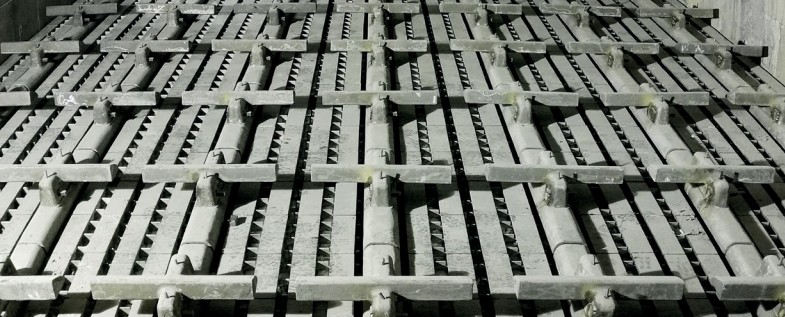In cement production, the selection of grate cooler grate plates directly affects cooling efficiency, equipment life and production costs. The working conditions of different production lines vary greatly, and blindly selecting standard models often leads to substandard performance or cost waste. Scientific selection needs to be based on an accurate analysis of its own production conditions, and a matching model is constructed from multiple dimensions.
1. Basic selection based on clinker characteristics
The physical properties of clinker are the primary basis for selection. For high-silicon clinker (SiO₂ content > 22%), its hard particles (Mohs hardness 7) cause extremely severe cutting wear on the grate plate, and grate plates with high hardness surface treatment should be preferred. High-aluminum clinker (Al₂O₃ content > 6%) is prone to form a viscous melt during the cooling process, and the risk of plugging is high. Long-hole grate plates (length-to-diameter ratio 3:1) should be selected, and the 30° inclination angle design can reduce the plugging frequency by 70%. The practice of an aluminate cement production line shows that this design extends the cleaning cycle from once a week to once a month. For production lines with large temperature fluctuations (such as frequent start and stop of rotary kilns), the grate plate needs to withstand severe thermal shock. Gradient material grate plates (surface Cr25Ni20 + internal Cr18Ni9) should be selected. Their thermal fatigue life can reach 800 cycles, which is more than 2 times higher than that of a single material.
2. Balance between production capacity and cooling efficiency
The production capacity scale determines the ventilation efficiency requirements of the grate plate. When the production capacity of the production line is greater than 5000t/d, a high opening rate design (opening rate > 35%) is required, such as a square hole grate plate (hole spacing 1.5 times the aperture) to provide a larger ventilation area. Small and medium-sized production lines (<2000t/d) pay more attention to cost control, and can choose a more cost-effective twill woven screen composite grate plate. Under the premise of ensuring basic cooling efficiency, the procurement cost is reduced by 30%. However, it should be noted that its wear resistance is limited and it is suitable for working conditions with low clinker hardness. The type of cooler also needs to be matched: the push-type grate cooler needs to use a movable/fixed combination grate plate (activity rate 30%-50%), and the walking grate cooler needs a special integral walking grate plate, and its support rib strength needs to be 50% higher than the ordinary type to withstand the stepping impact.

3. Accurate matching of temperature field distribution
The temperature difference in different areas of the grate cooler requires differentiated selection. The high temperature section (entrance area, temperature 1000-1400℃) must use ZG40Cr25Ni20 material, and its Cr₂O₃ oxide film can still maintain density (porosity <1%) at 1150℃. The medium temperature section (intermediate zone, 600-1000℃) is suitable for ZG30Cr26Ni5 material. The added 0.1% N element forms a Cr₂N strengthening phase, which keeps the yield strength at 650℃ above 350MPa. In one case, the service life of the grate plate of this material in the medium temperature zone is 30% longer than that of ZG35Cr24Ni7SiN, and the cost is reduced by 20%. In the low temperature section (exit zone, <600℃), wear-dominated failure can be selected. ZG30Cr18Mn12Si2N can be selected, which has a wear resistance 40% higher than that of heat-resistant steel. In the application of a limestone cement production line, the replacement cycle reaches 18 months.

4. Coordinated adaptation of equipment parameters
The grate plate selection needs to match the ventilation system parameters of the grate cooler. When the fan pressure is greater than 8kPa, the compressive strength of the grate plate needs to be ≥400MPa, and it is recommended to use an "I"-shaped reinforcement structure.
For movable grate plates, the movement frequency (usually 3-5 times/min) determines the selection of the sealing structure. For high-frequency movement scenarios, stepped seals + fluororubber strips are required to control the leakage rate below 0.5%, while ordinary flat seals can be used in low-frequency scenarios to reduce costs.
The width of the grate bed also affects the selection: wide grate beds (>4m) need to adopt a modular design, and the weight of a single grate plate is controlled within 50kg for easy replacement; narrow grate beds (<2.5m) can use integral grate plates to reduce the leakage problem caused by the splicing gap.
The correct grate plate selection is not a simple parameter matching, but a systematic project based on a deep understanding of the "personality" of its own production line. Only by converting the working condition data into quantifiable selection indicators and combining them with the full life cycle cost analysis can we find a solution that meets the performance requirements and is economically reasonable. It is recommended to establish a grate plate usage database to record the actual performance of different models, accumulate experience data for subsequent selection, and form a virtuous cycle of continuous optimization.